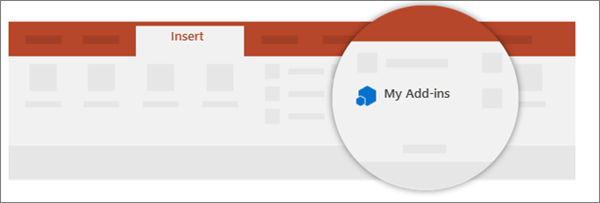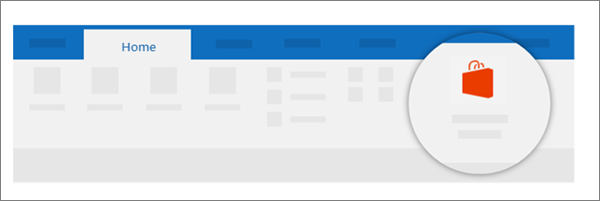User not seeing add-ins
Now that you've deployed the add-in, your end users can start using it in their Office applications. The add-in will appear on all platforms that the add-in supports.
For Word, PowerPoint, Excel (2016, 2019 or for Microsoft 365)
If the add-in supports add-in commands, the commands appear on the Office ribbon. In the following example, the command appears for the People Graph add-in in the Insert tab. The add-in command can appear on any tab.

If the deployed add-in doesn't support add-in commands or if you want to view all deployed add-ins, you can view them via My Add-ins from the Insert tab.

Then select the Admin Managed tab along the top in the Office Add-ins window. If add-in is not there, select Refresh in the top right corner.

For Outlook 2016, Outlook 2019 and Outlook for Microsoft 365
On the Home ribbon, select Store, as shown here. Select Admin-managed in the left nav.

Users can't see add-in? Try one of these:
Use the compatibility checker
- Outputs a status report for each user in your organization, whether they have a valid Office License, if they are set up correctly on Exchange, and if they are ready for centralized deployment. For more information, see deployment compatibility checker.
Check Office version requirements
The user might be on an older, incompatible version of Office. For add-ins to be deployed the user must have Office ProPlus or Microsoft 365. You can check this out for any member of your organization. To find out how, see Microsoft 365 reports.
Alternatively, you can check this manually by going to the application, such as Word, then select File > Account. Under Product Information, you should see Microsoft 365 Apps for enterprise.
Check Exchange requirements
Microsoft Exchange stores the add-in manifests within your organization's tenant. The admin deploying add-ins and the users receiving those add-ins must be on a version of Exchange Server that supports OAuth authentication. By default, Exchange Multi-Tenant and Dedicated VNext deployments support OAuth. Exchange Dedicated Legacy and hybrid on-premises deployments can be configured to support OAuth; however, it isn't the default configuration.
Check with your organization's Exchange admin to find out which configuration is in use. OAuth connectivity per user can be verified by using the Test-OAuthConnectivity PowerShell cmdlet.
For more information on requirements, see Determine if Centralized Deployment of add-ins works for your organization.
See regulations surrounding minors using add-ins
- Please see further information regarding minors using add-ins if applicable.
Check for nested groups
Add-ins will no longer appear to the user if the user is removed from a group that the add-in is assigned to.
Centralized deployment currently does not support nested group assignments. It supports users in top-level groups or groups without parent groups, but not users in nested groups or groups that have parent groups.
For more information, check out user and group assignments.
See also
Manage deployment of Microsoft 365 add-ins in the Microsoft 365 admin center.